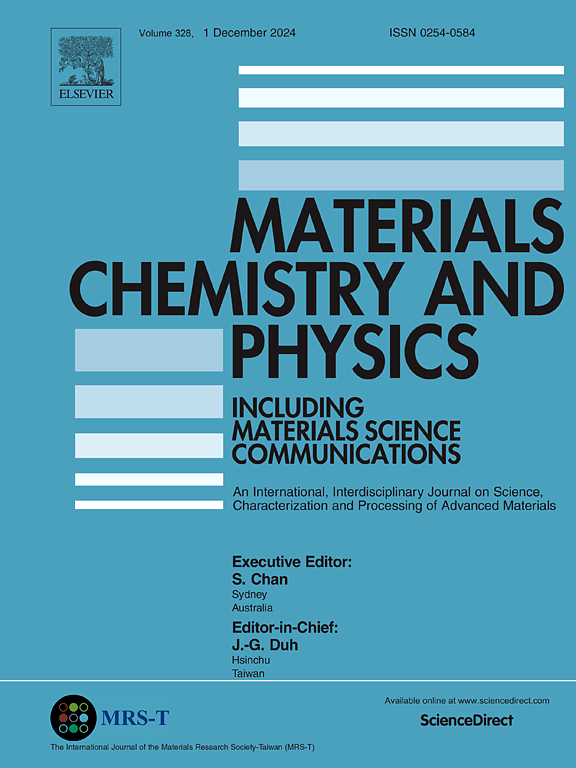Radiation-thermal modification of fluoroplastic composite and evaluation of its radiation-protective characteristics
IF 4.3
3区 材料科学
Q2 MATERIALS SCIENCE, MULTIDISCIPLINARY
引用次数: 0
Abstract
In the work the composite on the basis of fluoroplastic with filler WO3 is studied and its efficiency for protection against X-ray and gamma radiation is proved. The technological scheme of composite production has been developed and its physical and mechanical characteristics have been studied. The composite with 60 wt% of WO3 content has the following properties: density 3.35 ± 0.02 g/cm3, Vickers microhardness (at 300 g load) 5.38 ± 0.32 HV, flexural strength 18.86 MPa. The γ-radiation sources used were E(207Bi) = 0.570 MeV with an activity of 50 kBq, E(137Cs) = 0.662 MeV with an activity of 9 kBq, and E(60Co) = 1.252 MeV with an activity of 100 kBq. The X-ray radiation sources were isotopes 241Am (half-life T1/2 = 432.1 years; photon energy E = 59.5 keV; radioisotope activity 46 μCi) and 109Cd (half-life T1/2 = 461.4 years; photon energy E = 88 keV; radioisotope activity 15 μCi). It is shown that for reduction of gamma radiation with energy 1.252 MeV by 50 % a screen from pure fluoroplastic with thickness of 6.301 ± 0.654 cm is required, and for composite with 60 wt% WO3 the thickness of screen is 1.5 times less (4.077 ± 0.509 cm). Comparison of the linear attenuation coefficient at energy 0.662 MeV with modern analogs confirmed the high efficiency of radiation protection of the developed material. Radiation-thermal modification of the samples was carried out, which allowed to increase their radiation resistance to gamma radiation many times. After radiation-thermal modification the radiation resistance increased up to 1 ± 0.1 MGy and 4.5 ± 0.2 MGy for fluoroplastic and composite with 60 wt% WO3 content, respectively. And the initial bending strength increased in both materials by 15 % and more.
氟塑料复合材料的辐射热改性及其辐射防护特性评估
在这项工作中,研究了以氟塑料为基础、填充物为 WO3 的复合材料,并证明了其对 X 射线和伽马射线辐射的防护效率。开发了复合材料的生产技术方案,并对其物理和机械特性进行了研究。WO3 含量为 60 wt% 的复合材料具有以下特性:密度 3.35 ± 0.02 g/cm3、维氏显微硬度(300 g 负载时)5.38 ± 0.32 HV、抗弯强度 18.86 MPa。使用的 γ 辐射源为 E(207Bi) = 0.570 MeV,活度为 50 kBq;E(137Cs) = 0.662 MeV,活度为 9 kBq;E(60Co) = 1.252 MeV,活度为 100 kBq。X 射线辐射源是同位素 241Am(半衰期 T1/2 = 432.1 年;光子能量 E = 59.5 keV;放射性同位素活度 46 μCi)和 109Cd(半衰期 T1/2 = 461.4 年;光子能量 E = 88 keV;放射性同位素活度 15 μCi)。结果表明,要将能量为 1.252 MeV 的伽马射线减少 50%,需要使用厚度为 6.301 ± 0.654 厘米的纯氟塑料滤网,而对于含有 60 wt% WO3 的复合材料,滤网的厚度要小 1.5 倍(4.077 ± 0.509 厘米)。能量为 0.662 MeV 时的线性衰减系数与现代类似材料的比较证实了所开发材料的高效辐射防护性能。对样品进行辐射热改性后,其抗伽马射线辐射的能力提高了许多倍。经过辐射热改性后,氟塑料和 WO3 含量为 60 wt% 的复合材料的抗辐射能力分别提高到 1 ± 0.1 MGy 和 4.5 ± 0.2 MGy。两种材料的初始弯曲强度都提高了 15% 或更多。
本文章由计算机程序翻译,如有差异,请以英文原文为准。
求助全文
约1分钟内获得全文
求助全文
来源期刊

Materials Chemistry and Physics
工程技术-材料科学:综合
CiteScore
8.70
自引率
4.30%
发文量
1515
审稿时长
69 days
期刊介绍:
Materials Chemistry and Physics is devoted to short communications, full-length research papers and feature articles on interrelationships among structure, properties, processing and performance of materials. The Editors welcome manuscripts on thin films, surface and interface science, materials degradation and reliability, metallurgy, semiconductors and optoelectronic materials, fine ceramics, magnetics, superconductors, specialty polymers, nano-materials and composite materials.
 求助内容:
求助内容: 应助结果提醒方式:
应助结果提醒方式:


